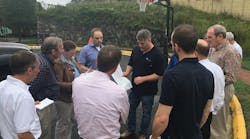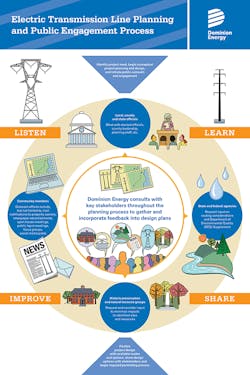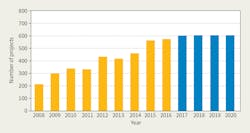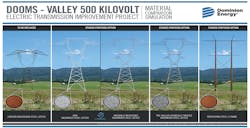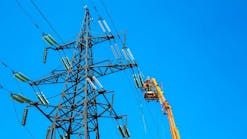Energy projects are facing growing scrutiny; even renewable projects are not immune. For Dominion Energy, uncovering the underlying differences in perceptions among internal and external stakeholders was key to rethinking its public engagement efforts.
Building trust, credibility and integrity in the communities where the energy company operates electric transmission infrastructure goes hand in hand with providing safe, reliable and cost-effective electricity. After several successful years of public outreach, a confluence of factors led Dominion Energy to launch an initiative to reimagine how it connects with its customers on electric transmission projects.
Dominion Energy has a mix of urban and rural communities in its service area. The energy company serves 2.6 million customer accounts in Virginia and North Carolina, U.S., as well as 17 cooperatives and 17 municipalities with more than 580,000 customer accounts. Among the fastest-growing energy companies in the PJM Interconnection market, Dominion Energy has experienced tremendous growth, especially in the Northern Virginia region.
Over the years, this growth and the North American Electric Reliability Corporation’s focus on reliability have resulted in increased demand and investment in electric transmission infrastructure. As it transitioned from a handful of straightforward projects to a long list of controversial projects, the energy company recognized it was time to take a more strategic approach to electric transmission communication.
Changing Landscape
In 2005, the 65-mile (105-km), 500-kV Meadow Brook-Loudoun line rebuild in rural Northern Virginia was a watershed project that changed how Dominion Energy engaged the public. Customers in rural areas argued that their property should not be impacted by infrastructure to meet purported demand in the overdeveloped areas of Northern Virginia. Therefore, issues such as the effect the line would have on their home values, viewshed and health were magnified.
In the years following the project, the dedicated communication team within Dominion Energy’s electric transmission organization was expanded to communicate the delicate balance between the need for reliable electric service and stakeholder expectations. As more projects were contested, the team successfully navigated uncharted territory and implemented many solid strategies for strengthening communication and customer relationships.
Deeper Dive
Today, the same customer themes are still relevant and consistently experienced across other projects, states and energy companies. As areas build up, customers are concerned about the proximity of projects to their homes, neighborhoods and schools. Existing lines or substations once in rural areas are now surrounded by development. In some cases, residents are unaware of easements located on or near their property. Upset customers combined with the ease of social media platforms can quickly result in misinformation, aggressive dialogue and organized opposition to projects. Therefore, how does an energy company seek meaningful engagement as times change?
In 2016, Dominion Energy launched a quantitative and qualitative research initiative with two Richmond, Virginia, firms after experiencing the changing landscape firsthand. This was more than evident in projects such as the 5-mile (8-km) Haymarket project in Prince William County, Virginia, where more than 800 property owners attended one open house and hundreds more submitted petitions to voice their concerns about a new 230-kV line. The purpose of the research initiative was to put data around the energy company’s experiential instincts.
For the quantitative piece, the objective was to measure Virginians’ attitudes about electric transmission infrastructure and Dominion Energy’s role as their energy provider. It also looked at the public’s reactivity to Dominion Energy’s engagement efforts. More than 800 people were surveyed. While a majority expressed at least some concern about the designing, planning and execution of electric transmission projects in their area, these respondents did note they had a high level of trust that Dominion Energy had their best interests in mind with new projects. However, this trust was fragile. Not surprisingly, more communication — without shying away from project details or complexities — was noted as the most effective way to alleviate concerns and bolster credibility.
For the qualitative piece, the objective was to identify new and deeper insights into how customers view electric transmission projects as well as new opportunities to improve the outcomes through storytelling. A diverse group of people was brought together to share expectations, positions on identified issues and potential solutions through their personal narratives.
This research revealed electric transmission projects ask a lot of communities and, in return, people want to feel the equation is balanced. Dominion Energy’s efforts should try to evolve stakeholder relationships from transactional interactions to values-based interactions. The energy company must show how it values what its stakeholders value. And, building trust with stakeholders must be through discussion, empathy and compromise.
Reaffirmation of Commitment
The research helped Dominion Energy’s electric transmission communication team to reaffirm its mission of positively affecting the energy company’s legacy in the community and demonstrating the company has the public’s best interest in mind. The team of eight, along with other internal subject-matter experts, continues to go into communities to discuss the need for a new electric transmission line project or substation as well as engage residents in the process of submitting an application to the Virginia State Corporation Commission (SCC). However, now the energy company has a better understanding of how its approach sets the tone for engagement.
The team established six guiding principles to help apply consistency across its program:
• Be humble and understanding
• Be overly informative
• Be extensive
• Be inclusive
• Be a partner
• Be present.
In the end, the team’s strategy is simple: Show up, tell the story and enhance communications.
New Approach
Thanks to the research, Dominion Energy’s electric transmission communication team recognized it was time to refine many of the items that had been done since the team’s creation. A foundational tactic is the open house. These events originally were designed to bring subject-matter experts on every aspect of an electric transmission project together — communication, planning, engineering, siting, permitting and construction — to talk with customers in an informal setting. Following the research initiative, the electric transmission communication team met with colleagues across Dominion Energy and pitched a new approach to open houses.
Whereas past open houses provided valuable information about projects, they did not provide attendees with a holistic view of Dominion Energy. What the team realized is the open houses were missing information on important topics — such as natural gas, renewables, distribution projects, career opportunities and so forth — that concerned customers and went a long way toward changing the value proposition. Because of the research, the open houses have been expanded to include more Dominion Energy resources and representation.
In addition, the team recognized Dominion Energy employees and retirees who live in the project areas are valuable ambassadors to have at the expanded open houses. These individuals are often neighbors and friends of the open house attendees. As a result, the team has begun extending invitations to these individuals through letters and emails.
Meeting Format and Frequency
In the spirit of early and frequent engagement, the team introduced public input meetings and construction informational meetings. For the 500-kV Dooms-Valley line rebuild in Augusta County, Virginia, the team held a public input meeting as a kickoff with the community. The team shared in a formal presentation the project need as well as the approach it would take to project planning and how the SCC application review process works. Afterward, subject-matter experts, including the project manager, were available to answer questions and discuss project considerations that would factor into which solutions were ultimately studied.
At the conclusion of the SCC review process, months can pass before construction and field communication begin. To reengage the community, a construction informational meeting was added to the team’s communication toolbox. A recent construction informational meeting for the 115-kV Four Rivers-Fredericksburg line rebuild gave attendees a flavor for what to expect once construction kicked off in the City of Fredericksburg, Virginia, and an opportunity to ask questions.
Small advisory groups also have been facilitated for projects such as the proposed Idylwood-Tysons project in Northern Virginia. This area in Fairfax County is densely populated, so the new 4.3-mile (7-km), 230-kV line will impact a large population. A series of three advisory group meetings — comprised of community leaders, environmental and business groups, and others with unique perspectives from the private and public sector — were held to analyze the potential routes as well as identify constraints and opportunities. A bus tour for the participants rounded out the experience, enabling them to see the study area firsthand.
Reaching Out
The research showed early, frequent and proactive awareness in building engagement is important to address concerns and close any knowledge gaps about projects. The team took a fresh look at its engagement opportunities, pinpointing the desire for area historic preservation and natural resource groups and Native American tribes to be more involved in the project planning process.
In the past, these groups provided input on projects as part of the SCC proceedings, but the team is now reaching out to them directly and earlier — before an SCC application is submitted and while the energy company is in the information-gathering phase and studying options, such as structure type and finish. The team is seeking input on historic, cultural and scenic resource concerns as well as how it can best balance energy infrastructure needs and historic, cultural and scenic resource preservation. This process change was captured on a new electric transmission line planning and public engagement process map that shows customers what they can expect.
The team revamped collateral materials — including brochures, open house boards, letters and postcards — to make them more understandable, concise and graphically appealing. For the new 230-kV Remington-Gordonsville line, the team sent out three postcards to property owners after the SCC approved the use of weathered steel monopoles and the flexibility to implement shorter H-frame structures by expanding the right-of-way from 100 ft to 140 ft (30.5 m to 43 m) with property owners’ consent. The postcards solicited interest from property owners. Also, for the 500-kV Dooms-Valley line rebuild, the team developed a material comparison simulation to show property owners the proposed structure types and finishes, and give them a way to engage and voice their preference.
Online and Social Media
The team also embarked on overhauling the energy company’s website, adding more graphics and pictures, moving the project benefits and updates to prominent locations, presenting older information in an expandable format for better page navigation, and improving accessibility to contact information. These changes were intended to enhance the user experience.
Project communication through visuals versus written materials has become a priority. The team introduced more video and better photo simulations to help with storytelling. For the 230-kV Possum Point-Smoketown line rebuild, the team worked with a vendor to develop an overview video, which it used for community events and on the energy company’s website. The team also took a different approach to simulations, offering more extensive views of existing and proposed configurations.
A series of videos was created on popular topics such as the routing and siting process, right-of-way easements, preconstruction and construction processes, and the difference between transmission and distribution lines. The videos were posted on the energy company’s website to provide customers with greater awareness of general topics.
The team also took a new approach to social media by launching a pilot focused on four 230-kV electric transmission projects in construction: Poland Road, Yardley Ridge, Warrenton-Wheeler-Gainesville and Possum Point-Smoketown. The energy company had been using social media for years but never to communicate specific information related to its electric transmission projects. The team used dark posts, separate from the main Dominion Energy Facebook page, and geofencing to target individuals who lived in or traveled through the project area with key messages. The messages ranged from evergreen messages such as low rates and reliability to more time-sensitive project-related messages about open houses, tree clearing, installing access roads, matting and more.
Lessons Learned
Overall, the research initiative resulted in valuable learning for Dominion Energy. It helped the energy company to identify new opportunities to improve the public’s perception of projects and processes, and it reenergized its commitment to better communication and minimizing the impact of new infrastructure on customers.
In the years to come, as Dominion Energy continues to expand its electric transmission footprint — bringing even more reliable, affordable electricity to communities — it will approach its customer relationships with renewed standards thanks to the insights gained from this research initiative. ♦
Julie Mills Taylor is a senior communication specialist at Dominion Energy. She holds a BS degree in communication from the University of Tennessee and has worked as a communicator in the energy industry for 20 years.
Greg Mathe is a communications consultant for Dominion Energy and oversees the communication planning and public engagement efforts for electric transmission projects. He holds a BS degree in political science from Gettysburg College and has 15 years of strategic communication experience.
